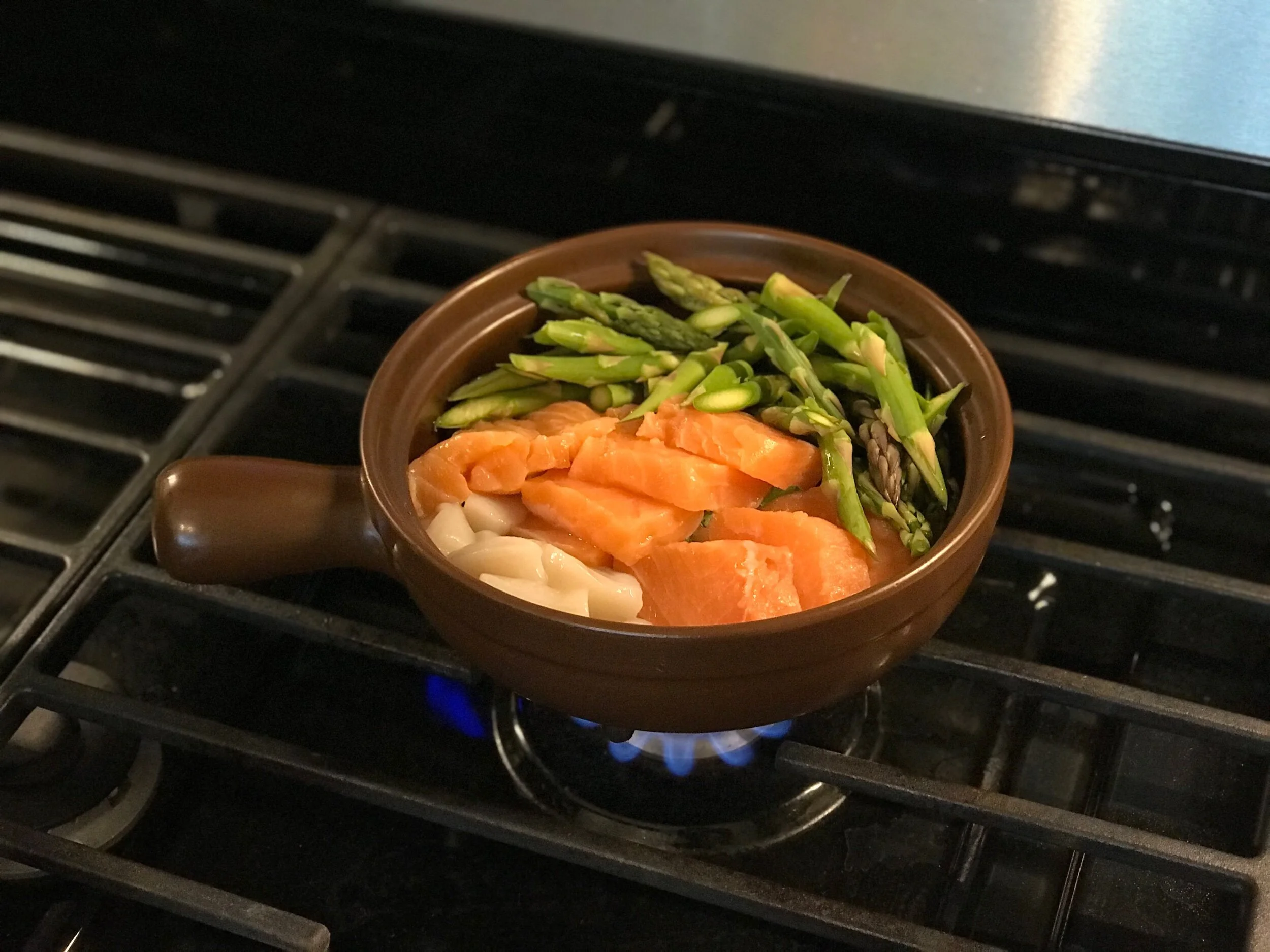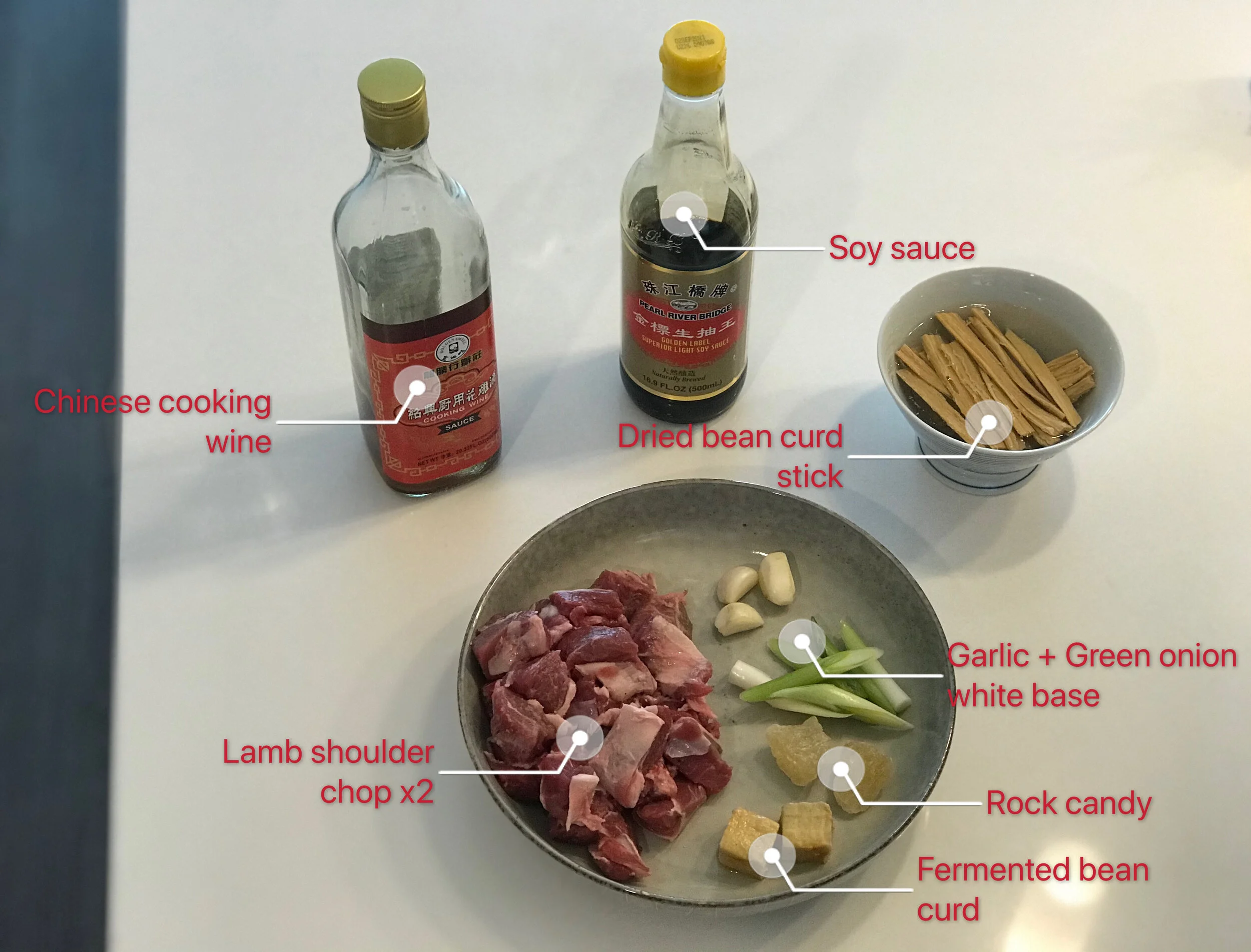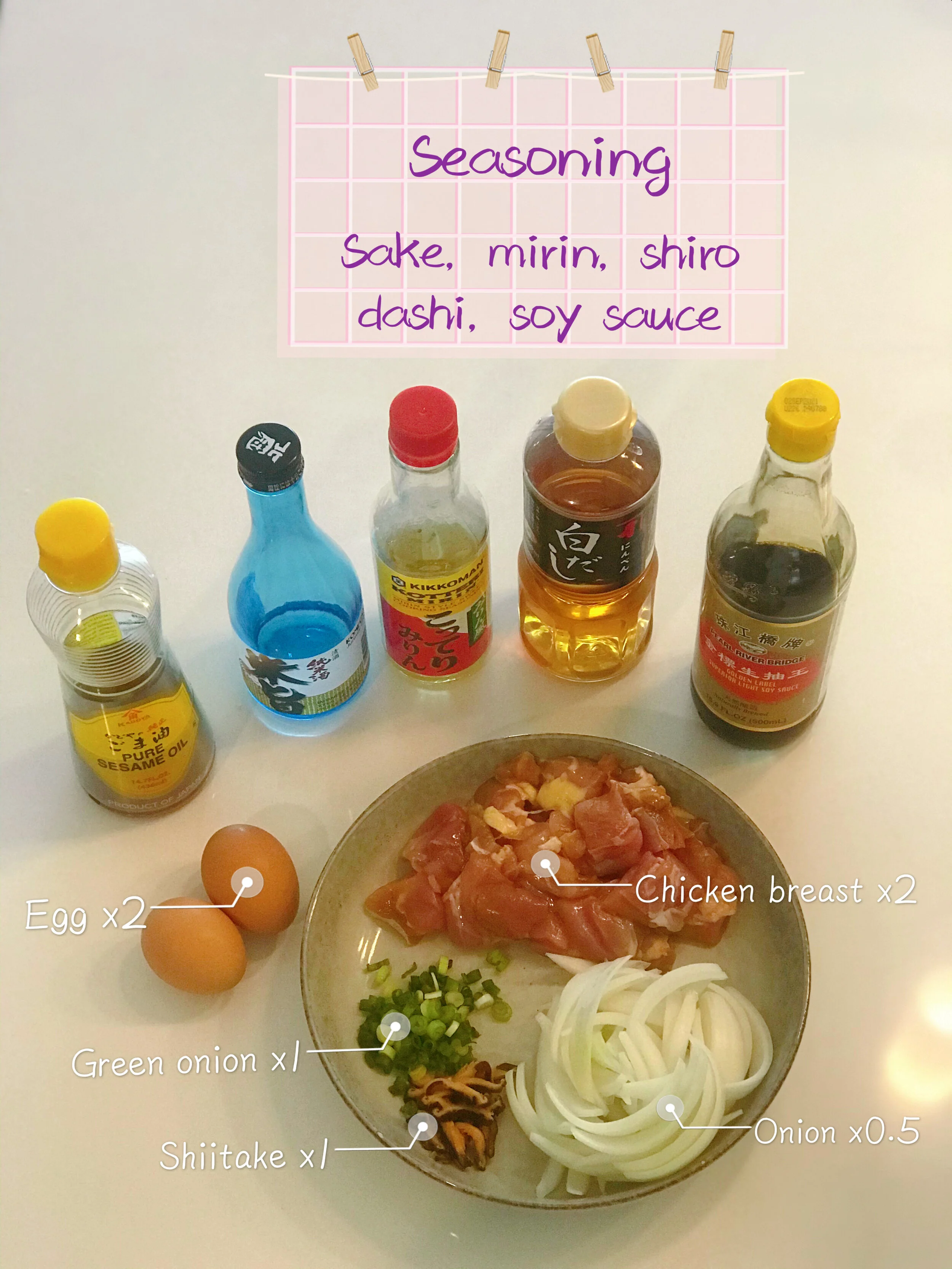When you run out of cooking ideas, try this one pot miso soup! You can use any ingredient you have, just chop it up and then cook in medium heat. Often I add dumplings too. Instead of miso, I also recommend water + sake for a lighter soup base. Recently I also tried tomato + water as base and add hotpot ingredients for the one pot meal. Quick and easy, and most importantly warm and yummy for a cold day!
Cantonese-style Braised Lamb Casserole
Lamb is a popular meat to consume during fall/winter months as it is believed to be helpful for warding off the chill. Gathering only what I have home, this recipe is a dumped down version of the Cantonese style braised lamb casserole. It is perfect to ward off the chill during this COVID-19 battle! If you are making it for a big party, you can prepare the casserole as a hot pot - serve over tabletop stove and prepare romaine lettuce on the side for dipping into the stew.
The following recipe makes two servings.
Ingredients
Lamb should chop x 2, diced
Garlic x 3, lightly pressed using knife
Green onion white base from two stalks
Rock candy, you can add small amount at a time until the taste if right.
Fermented bean curd x 2
Dried bean curd, pre-soaked in water
Notes
Lamb breast is a better cut for this casserole if you are looking for tenderness and some more fat
Usually I would add some carrot chunks and shiitake to the casserole; there are many variations, roasted chestnut is a common ingredient to add as well
You can use a similar technique to make pork belly casserole as well
I once learned that the role of rock sugar in meat stews is to function as a natural tenderizer.
Seasoning mixture
Chinese cooking wine x3 tbsp
Soy sauce x2 tbsp
Instructions
Blanch lamb in boiling water for ~ 1 minute, then drain and rinse with cold water.
Fry garlic and white base of green onion over medium heat.
Stir in lamb meat.
Add fermented bean curd and stir quickly.
Add the cooking wine and soy sauce mixture and stir quickly.
Add rock candy and enough water to cover all the ingredients. Bring to boil, then cover and simmer over low heat for ~30 minutes or until meat is tender.
Add bean curd stick and cook for another 15-20 minutes until the bean curd stick soaks up the moisture and become soft.
Serve in a casserole or as a hot pot over heat.
Oyakodon 親子丼
First cooking blog, sharing a simple recipe that takes <30 minutes to prepare. It is chicken, egg, and onion cooked simmered in a soy sauce based mixture and then served over a bowl of rice. I added some shiitake mushroom which goes well with chicken.
A popular dish in Japan, Oyakodon is translated to “parent-and-child rice bowl”. When I first saw this on the menu, I thought it meant a dish that’s for everyone, for the adult and for the kid, from the literal meaning of the kanji. It made total sense, since the ingredients are quite healthy. Later I found out it actually meant parent (chicken) and child (egg) on rice! There’s a fish variation: salmon sashimi and salmon roe rice bowl. How amusing!
The following recipe makes two servings, each serving is prepared individually.
Ingredients:
Chicken breast x 2, cut in chunks
Onion x 0.5, sliced
Shiitake x 1, sliced
Green onion x 1, chopped
Egg x 2, beaten
Seasoning Mixture
Mix about 1.5 tbsp of sake, mirin, shiro dashi, and soy sauce with enough water to dilute to taste of preference. Usually sugar is also added to the mixture and balances the umami flavors from the other sauces. Alternatively, sukiyaki sauce, which basically a mixture of mirin, sugar and soy sauce, can also be used for this dish.
Instructions
1. Lightly fry half of the onion in heated sesame oil.
2 Pour half of the seasoning mixture over the onion.
3. Add half of the chicken and the shiitake mushroom and bring to boil.
4. Cover for ~5 minutes, until the chicken is cooked thoroughly.
5. Drizzle one beaten egg and cover briefly until the egg is cooked to your preference.
6. Sprinkle green onion and it’s ready to be served!
My Top Two Favorite Spots in Tokyo
A brief post to recommend Futakotamagawa (二子玉川) and Okutama (奥多摩), my favorite places in Tokyo. If you are looking for a different feel of Tokyo and to get away from the shopping and crowds, check these two spots out!
I liked Futakotamagawa for the long stretch of greenery along Tama River. It was the perfect place to enjoy a cycling day under the sun with some windchill, while overlooking the high-rises from the metropolitan area from afar. I recall the ward offered free bicycle rental options for residents / foreigners with passports which was a nice perk.
An interesting place to visit in Futakotamagawa is the Tsutaya Electrics, a large lifestyle store where you can browse books from the bookstore section or play around with some home appliances / gadgets in the electronics section.
Jiyugaoka, which is nearby, is also a trendy place to visit!
Whenever I didn’t feel like mountain hiking, I would think of Okutama, another outdoor haven close to Tokyo. I highly recommend it to anyone looking for light hiking options. There is the Hatonosu Ravine as well as the Okutama Lake, both with easy hiking trails and suitable for a relaxing day out.
Yokohama: Chinatown & Cup Noodles Museum
Dedicating a post to Yokohama (横浜市), which is the second largest city in Japan after Tokyo and also synonymous with Chinatown for many, especially the Chinese population living in Japan.
Yokohama is situated by the Tokyo Bay and it is less than an hour away from Tokyo by public transportation. I particularly liked the waterfront. Biking, strolling, sitting in the park, feeling the sea breeze, This is a great day trip spot from Tokyo if you want something that’s less nature!
The Chinatown there is the largest one in Japan. It is by far the most crowded Chinatown I have visited. This place is very very touristy, with restaurants after restaurants and rarely you see supermarkets like in other Chinatown. In there you also won't hear shop owners or regular customers speaking the Taishan dialect, like what I encountered in Chinatowns in North American cities. Yes, the Yokohama Chinatown is quite Japanese. There are even souvenir shops that sell Japanese-style Chinese sweets/food. Nevertheless, this is a great spot to satisfy a Chinese expat craving for some authentic Chinese food when living in Tokyo.
Aside from the Chinatown, Yokohama has many interesting spots, one of which is the Cup Noodles Museum. Yes, a museum for cup noodles. It is perhaps more well-known for the make-your-own-cup-noodles workshop. The exhibits in the museum are actually very fascinating as well. First introduced in 1958, the instant noodles were invented by Momofuku Ando 安藤百福 after one year of hard work in a small house and sleeping only a few hours a night. The unique deep-fried drying method was inspired by Mrs. Ando's cooking of tempura one night. Instant noodles became an instant hit, but they didn't become the global food until the cup noodles version which was introduced in 1971. The convenience of cup noodles make them ideal for many occasions, including as a snack during long-haul flights. Mr. Ando didn't stop just there. In 2005, at the old age of 90+, he invented the Space Ramen, instant noodles that can be eaten in space. Be creative. Always go above and beyond. Never give up. The Cup Noodles Museum is a charming place that it is fun for kids and at the same time it is inspiring for adults. Note: if you want to make your own cup noodles, be prepared to spend a few hours in the museum to wait for your time slot, unless you go very early. Maybe going in a weekday would be the best to cut the line.
Chinatown and the Cup Noodles Museum are the two places I have explored. There are many other things to do in this big city. For shopping, there is the Red Brick Building. For nature, there is the Yamashita Park. For culture, there is the classical Senkeien Garden.
























